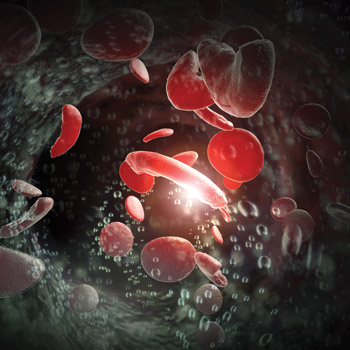Selecting a sickle cell therapy
An expert reviewed the available drugs for patients with sickle cell disease and offered advice on how to use them.
In the past few years, the number of drugs approved by the FDA for sickle cell disease has quadrupled. But that's still not saying much, according to Sophie M. Lanzkron, MD, professor of medicine and oncology and director of the Sickle Cell Center for Adults at Johns Hopkins in Baltimore.
“This was the first molecular disease described in man, and now we only have four therapies that are approved, so we're still behind where we should be in treating this disease,” said Dr. Lanzkron during Internal Medicine Meeting 2021: Virtual Experience.

As part of her session on what's new in sickle cell, she reviewed the available drugs for the condition and offered advice on how to use them.
Hydroxyurea
First up, Dr. Lanzkron covered the old standby, hydroxyurea, approved in 1998. The drug's use for this indication was based on the discovery that, in the presence of fetal hemoglobin, sickle hemoglobin does not polymerize and cause red cells to sickle and that sickle cell patients who naturally have more fetal hemoglobin have less pain, acute chest syndrome, and premature mortality.
Hydroxyurea increases fetal hemoglobin and was found to reduce crises among sickle cell patients in a landmark trial published by the New England Journal of Medicine (NEJM) in 1995. “It is the only randomized controlled trial of hydroxyurea in the adult population,” said Dr. Lanzkron. However, the field is convinced enough of the drug's benefits that it would now be unethical to randomize patients to it versus placebo, she explained.
Additional support for hydroxyurea's use has come from nonrandomized research, such as a long-term study in Greece that compared patients who took the drug with those who didn't and was published by Blood in 2010. “There are two observational trials, both in the same direction with similar results, showing a survival benefit of being on hydroxyurea,” said Dr. Lanzkron.
However, successful hydroxyurea therapy requires avoiding a number of common pitfalls, which Dr. Lanzkron reviewed.
For starters, don't assume that patients who already have fairly high fetal hemoglobin levels don't need the drug. “Patients who have fetal hemoglobin levels that are high—if they meet the clinical criteria for going on hydroxyurea, so having crises, symptomatic anemia, acute chest syndrome—I will start them on hydroxyurea,” she said.
In some cases, it's the patient who doesn't want to take hydroxyurea, due to concerns about toxicity. “This takes time and trust with patients to talk to them about the issues,” said Dr. Lanzkron. “There actually is very little toxicity described in the sickle cell population with hydroxyurea.” Tools from the American Society of Hematology can help with these conversations, she noted.
“Another mistake I see is failing to try and titrate the dose to the maximally tolerated dose,” which is a neutrophil count between 2,000 to 4,000 per microliter and reticulocyte and platelet counts of at least 90,000 per microliter, she said. Too short a trial of hydroxyurea is also a common problem. “Patients and providers should be aware that it could take three to six months to see an effect,” said Dr. Lanzkron.
Finally, there's adherence, which should be maintained in almost all situations. “We don't stop hydroxyurea during hospital admissions unless there's some issue with patients' counts being too suppressed,” she said.
Newer therapies
Almost 20 years after the approval of hydroxyurea for sickle cell, L-glutamine joined the armamentarium, in 2017.
“The mechanism of action in sickle cell disease is not exactly clear,” said Dr. Lanzkron. “There has been no demonstration of an improvement in hemoglobin or a decrease in reticulocyte count.” The effect is clearer than the cause; a trial published by NEJM in 2018 found fewer pain crises and hospitalizations among patients randomized to the drug.
L-glutamine carries some practical disadvantages, though. “This is, unfortunately, a powder that patients have to take with a liquid twice a day, which has an impact on adherence to therapy,” she said. It also costs approximately $3,000 per month for an adult patient, “so it's about 20 times more expensive than hydroxyurea.”
In 2019 came crizanlizumab, a humanized monoclonal antibody that binds to P-selectin and blocks its interaction with its ligand. Evidence of effectiveness came from a randomized trial that compared a low and high dose to placebo. The high-dose group had about half as many crises as the placebo group, according to results published by NEJM in 2017.
Another significant finding was that the drug worked in all the major genotypes of sickle cell disease, something that isn't true of the other medications. Crizanlizumab, which is delivered as a monthly infusion, also appeared safe in the trial. “But since its approval, there have been some reports of patients developing severe painful events occurring during the infusion of this drug,” said Dr. Lanzkron.
Patients' pain from the infusions may have been exacerbated by use of steroids to treat it, which the manufacturer of crizanlizumab has subsequently recommended against. “And if patients can get through the first two or three doses without a problem, then we do not see this problem in future infusions,” she said. There is once again the issue of cost, estimated at $80,000 to $100,000 a year.
The final new option is voxelotor, a polymerization inhibitor that reversibly binds to hemoglobin to increase its oxygen affinity, which was tested in a trial published by NEJM in 2019.
“The primary endpoint, interestingly, for this study was a hemoglobin response,” said Dr. Lanzkron. “This drug is really interesting because it addresses the primary problem, the event of sickling, and so one would think that if you're affecting a primary problem, that you should be able to decrease downstream complications, including the development of vaso-occlusive crisis, but we don't really have that data yet.” Voxelotor comes as a pill, taken once daily, but is also expensive, at about $125,000 per year.
Treatment decisions
Hydroxyurea remains Dr. Lanzkron's first-line therapy for most patients with sickle cell. She considers crizanlizumab as first-line therapy for patients who have sickle cell variants and multiple crises a year and as second-line therapy for others. L-glutamine is third-line, or second-line for those who don't want an IV infusion. Voxelotor is her go-to only to treat symptomatic anemia that doesn't respond to hydroxyurea.
There is one more therapy she uses, mostly for patients with chronic pain and frequent crises, and that's transfusion. Guidelines from the National Heart, Lung, and Blood Institute, published in 2014, only recommend chronic transfusions in adults with sickle cell to prevent recurrent strokes, but trials have shown that it also reduced pain and hospitalizations, Dr. Lanzkron said.
Transfusion is a better solution to significant chronic pain in sickle cell patients than IV opioids, which she definitely does not recommend. But her main advice on this challenging care decision is to hand it over to an expert. “I don't think that primary care physicians should be doing this,” she said. “I think that sickle cell experts should be managing this, because we're in the best position to sit and think about patients' specific treatment plans.”
The good news is that after a very long wait for advances in the field, everyone treating sickle cell disease should have more options in the near future. “It's really an exciting time in sickle cell disease. We have a number of new therapies, and there are about 40 new agents in the pipeline, which is really great,” said Dr. Lanzkron.





